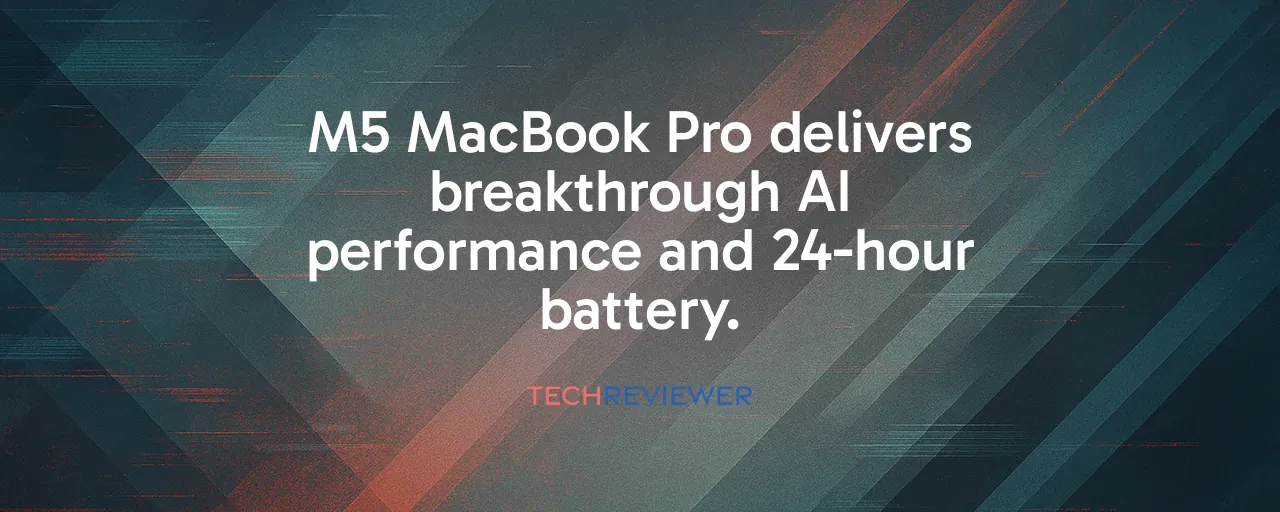A Leap Forward in Laptop Performance
Apple's latest 14-inch MacBook Pro, powered by the M5 chip, arrived on October 15, 2025, with a clear message: laptops can do more than ever before. Designed for those who push their machines to the limit, this release centers on a chip that blends raw power with efficiency. The M5's 10-core GPU, each core packed with a Neural Accelerator, delivers up to 3.5 times faster AI performance compared to the M4 and six times that of the M1. For anyone running complex AI models or rendering high-resolution graphics, this kind of speed feels like a breakthrough.
Beyond AI, the M5 MacBook Pro tackles everyday demands with finesse. Its 10-core CPU, built on TSMC's third-generation 3-nanometer process, offers a 20% boost in multithreaded performance over the M4. Add in storage speeds twice as fast as the previous generation and a battery that lasts up to 24 hours, and you've got a machine that keeps up with long workdays, whether you're editing 8K video or analyzing data on the go. Apple has kept the starting price at $1,599, making it a compelling option for professionals and students alike.
Powering Creativity With Real-World Impact
For creative professionals, the M5 MacBook Pro is a game-changer without the hype. Take video production companies, for example. Teams using software like Final Cut Pro can now handle real-time 8K editing with smoother playback and faster rendering, thanks to the M5's GPU, which delivers 1.6 times the graphics performance of its predecessor. The third-generation ray tracing technology also makes a difference, letting editors apply complex effects without lag. One production studio reported slashing rendering times significantly, allowing tighter project deadlines without sacrificing quality.
The M5's impact extends beyond Hollywood-grade editing. University researchers deploying local large language models for data analysis have found the chip's Neural Accelerators cut processing times dramatically. Unlike cloud-based solutions, these models run directly on the laptop, keeping sensitive data secure. This shift to on-device AI processing means researchers can iterate faster without worrying about cloud costs or privacy breaches. Both cases show how the M5 turns raw power into practical results, whether you're crafting visuals or crunching numbers.
Balancing Power and Practicality
What sets the M5 MacBook Pro apart isn't just its horsepower but how it fits into real life. The 24-hour battery life means students can go from morning lectures to late-night study sessions without hunting for an outlet. Remote workers benefit from the 12MP Center Stage camera, which keeps video calls sharp and centered, and the six-speaker sound system delivers crisp audio for presentations or downtime streaming. The nano-texture display option cuts glare, making it easier to work in bright environments, from coffee shops to outdoor shoots.
Apple's focus on privacy also shines through. On-device AI processing ensures sensitive data remains on the device rather than being transmitted to external servers, supporting compliance with privacy standards and reducing exposure risks. The unified memory architecture, now with 153 gigabytes per second bandwidth, ensures seamless data flow between CPU, GPU, and Neural Engine, letting apps like Adobe Photoshop and LM Studio run smoothly. These features make the MacBook Pro a versatile tool for diverse users, from creatives to enterprise teams.
Facing the Competition Head-On
Apple isn't alone in the race for AI-driven laptops. Qualcomm's Snapdragon X Elite and X2 Elite processors, powering Windows laptops with 24-25 hour battery life, give the M5 a run for its money. Intel's Core Ultra and AMD's Ryzen AI chips, with NPUs hitting 47-50 TOPS, challenge Apple in raw AI performance. Some Windows systems also offer broader software compatibility, especially for enterprise environments or specialized engineering tools, where macOS still lags.
Yet Apple holds its ground with tight hardware-software integration. The Metal 4 and Core ML frameworks let developers tap into the M5's power without rewriting apps, a boon for those building AI tools. Unlike modular PCs, the MacBook Pro's closed ecosystem prioritizes efficiency and security, though it sacrifices upgradeability. For users tied to Windows workflows or DirectX gaming, these trade-offs might sting. Still, Apple's consistent pricing and long-term software support make the M5 MacBook Pro a strong contender in a crowded market.
What's Next for AI Laptops
The M5 MacBook Pro sets a high bar, but the broader laptop market is catching up fast. With AI PCs projected to make up 43% of global shipments in 2025, features like on-device processing and extended battery life are becoming standard expectations. Apple's unified silicon strategy, now spanning MacBook Pro, iPad Pro, and Vision Pro, gives it an edge in scaling performance across devices. But competitors like Microsoft, Dell, and Lenovo are leaning hard into Qualcomm and AMD partnerships to match these gains.
Looking ahead, the M5's focus on local AI could spark wider adoption of privacy-first computing, especially as regulations like GDPR push for data security. For users, this means more power to create, analyze, and explore without relying on the cloud. Whether you're a video editor racing against a deadline or a researcher guarding sensitive data, the M5 MacBook Pro delivers a glimpse of where laptops are headed: powerful, efficient, and built for a world that demands both.
